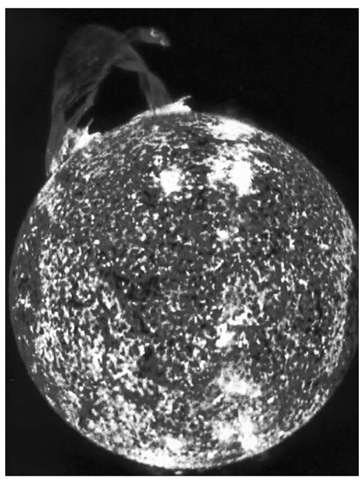SUNLIGHT IS THE electromagnetic radiation given off by the sun. It is passed through the atmosphere to the Earth, where the solar radiation is reflected as daylight. Sunshine results when the solar radiation is not blocked. Sunlight is the primary source of energy to the Earth. It provides infrared, visible, and ultraviolet (UV) electromagnetic radiation with different wavelengths. Small sections of the wavelengths that are visible to the human eye are reflected as rainbow colors. Sunlight may be recorded using a sunshine recorder. Electromagnetic waves are waves that are capable of transporting energy through the vacuum of outer space and that exist with an enormous continuous range of frequencies known as the electromagnetic spectrum. The spectrum is divided into smaller spectra on the basis of interactions of electromagnetic waves with matter.
The longer-wavelength, lower-frequency regions are located on the far left of the spectrum, and the shorter-wavelength, higher-frequency regions are on the far right. Two very narrow regions within the spectrum are the visible light region and the X-ray region. The visible light region is a very narrow band of wavelengths located to the right of the infrared region and to the left of the UV region. Though electromagnetic waves exist in a vast range of wavelengths, human eyes are only sensitive to the visible light spectrum. The visible portion of the solar spectrum lies between 400 and 700 nm. and separates the UV region of shorter wavelengths from the infrared region of longer wavelengths. A combination of waves results in white light. Red has the longest visible wavelength, whereas violet has the shortest. Waves longer than red are known as infrared, and waves shorter than violet are called UV.
Sunlight is Earth’s primary source of energy, providing infrared, visible, and ultraviolet electromagnetic radiation.
The sun is the closest star to the Earth and the most closely studied. It is at the center of the solar system and accounts for about 99.8 percent of the mass of the solar system. The planets revolve around the sun. The sun is composed of hydrogen, helium, and other trace elements and goes around the center of the Milky Way galaxy at a distance of about 26,000 light years from the center of the galaxy. The amount of solar energy incident on the Earth’s atmosphere is about 342 Watts per sq. m.r, based on the surface area of the Earth. Although the Earth’s surface continuously radiates energy outward to space, only part of the surface area receives solar radiation at a time. Most of the solar energy incident on the Earth is in the UV region of shorter wavelengths. The sun is the source of heat that sustains life on Earth and controls the climate and weather. Only the sun’s outer layers, which consist of the photosphere, the chromosphere, and the corona, can be observed directly. These three regions have different properties from one another, with regions of gradual transition between them. The sun has basically the same chemical elements as are present on the Earth. However, the sun is so hot that all of these elements exist in the gaseous state. Energy generated in the sun’s core takes a million years to reach its surface. Solar energy is created deep within the core of the sun, where nuclear reactions take place.
SUNLIGHT AND THE DANGER OF SKIN CANCER
Every living thing exists because of the light from the sun. Sunlight is important in photosynthesis. For humans, UV light in small amounts is beneficial because it helps the body produce vitamin D from the UV region of sunlight. However, excessive exposure to sunlight is dangerous, as it can cause sunburns, skin cancer, and aging. UV light wavelengths are short enough to break the chemical bonds in skin tissue, and when the skin is exposed to sunlight, most skin will either burn or tan. The skin undergoes certain changes when exposed to UV light to protect itself against damage. The epidermis thickens, blocking UV light, and the melanocytes make increased amounts of melanin, which darkens the skin, resulting in a tan. Melanin absorbs the energy of UV light and prevents the light from penetrating deeper into the tissues. Sensitivity to sunlight varies according to the amount of melanin in the skin. Darker-skinned people have more melanin and therefore have greater protection against the sun’s harmful effects. The amount of melanin present in a person’s skin depends on heredity as well as on the amount of recent sun exposure. Albinos have little or no melanin. The more sun exposure a person has, the higher the risk of skin cancers, including squamous cell carcinoma, basal cell carcinoma, and malignant melanoma. Actinic keratoses (solar keratoses) are precancerous growths also caused by long-term sun exposure.
UV light, although invisible to the human eye, is the component of sunlight that has the greatest effect on human skin. Sunlight deficiency could increase blood cholesterol by allowing squalene metabolism to progress to cholesterol synthesis rather than to vitamin D synthesis, as would occur with greater amounts of sunlight exposure. Larger amounts of UV light damage the body’s DNA and alter the amounts and kinds of chemicals that the skin cells make. UV light may also break down folic acid, sometimes resulting in a deficiency of that vitamin in fair-skinned people. UV light is classified into three types, UVA, UVB, and UVC, depending on its wavelength. Although UVA penetrates deeper into the skin, UVB is responsible for at least three quarters of the damaging effects of UV light, including tanning, burning, premature skin aging, wrinkling, and skin cancer. The amount of UV light reaching the Earth’s surface is increasing, especially in the northern latitudes. This increase is attributable to chemical reactions between ozone and chlorofluorocarbons that are depleting the protective ozone layer, creating a thinner atmosphere with some holes. The key to minimizing the damaging effects of the sun is avoiding further sun exposure. It should be noted that damage that is already done is difficult to reverse.

